Hello from Paris! I will be staying in the city of lights (and rain) for the next 8 full days for a Historical Paris class. Because this is a class trip, I will be following an itinerary in the morning, but the afternoons will be free for me to chose what I want to do.
Day 1: Bonjour!
Day 2: The Louvre, Les Tuileries, L’Orangerie and ...
Day 3: Orsay Museum and Montmartre
Day 4: Rodin Museum, Les Invalides, Eifel Tower, Fauchon, Opera Garnier
Day 5: The Island of the City and the Left Bank
Day 6: Gregorian Mass, Versailles, and Arc night shots
Day 7: THe Pompidou, Pantheon and walking about
Day 8: Carnavalet Museum, Eiffel Tower and La Defance
Thank you for looking. I hope you've enjoyed my blog.
Wednesday, January 30, 2008
Wednesday, January 23, 2008
Day 8: Carnavalet museum, Eiffel Tower, and La Defance
Yesterday was the last day of itinerary travel we had. We started off at the Carnavalet Museum, which is the museum for the city of Paris. I think my mom would have enjoyed this museum the most. The museum is within two connected mansions in Paris, both of which have beautiful paneled wall and a lot of furniture and art left to decorate the rooms. This museum is free, which is the other plus, and covers the history of the city from the Roman Gallo times all the way into the 20th century.
This bronze statue of Louis the 14th was one of the few to survive the revolution
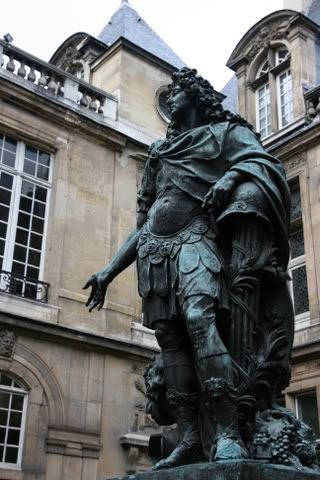
Painting of the Pont Neuf bridge

Erin shows off this beautiful and little bed

Painting of Les Invalaides before all of the development went up around it
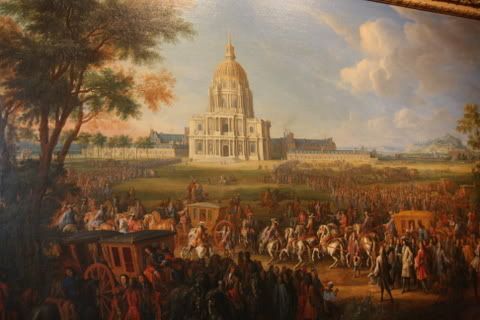
Fire at a hotel. It made us laugh because the fire looks quite a bit like the fire symbol we saw on the exit signs
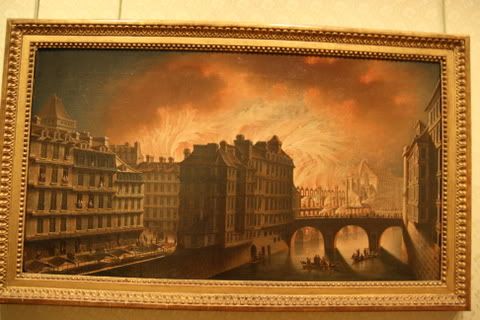
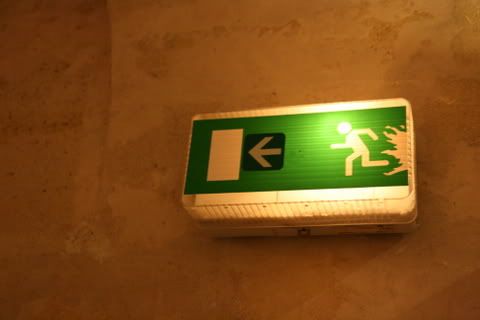
This painting is of the Champs Elysees, you can see it in the left hand side of the painting. It ends at the gardens of the Tuileries
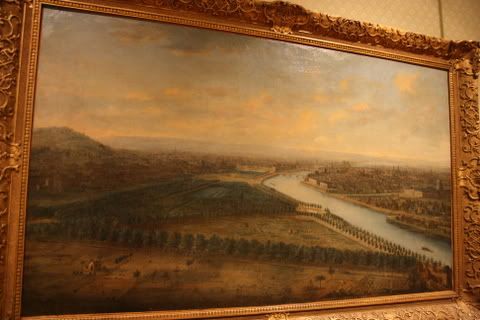
Some of the walls within the museum:
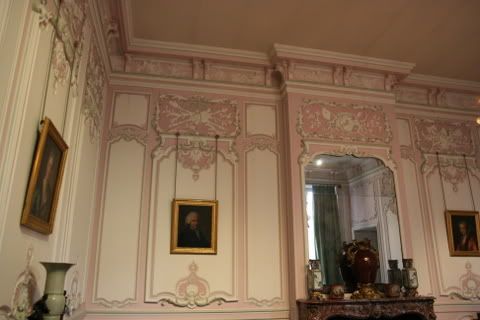
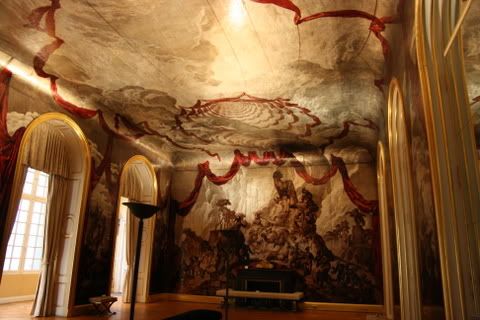
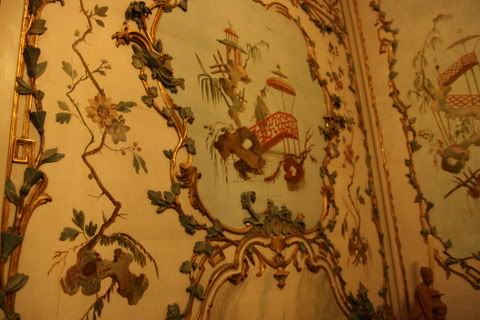
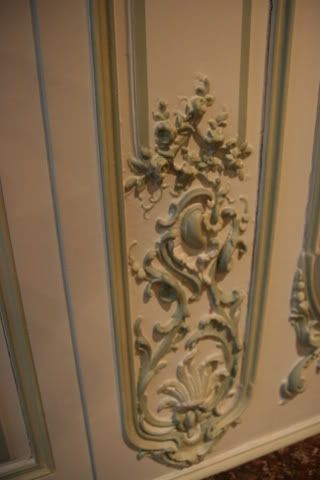
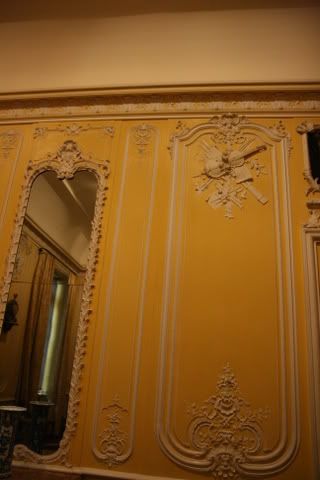
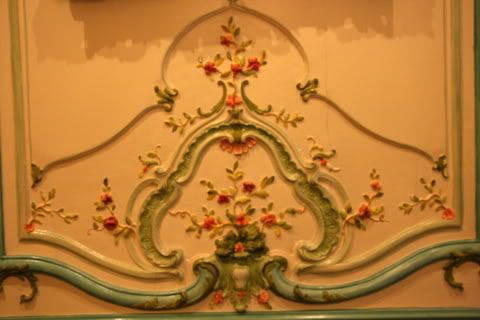
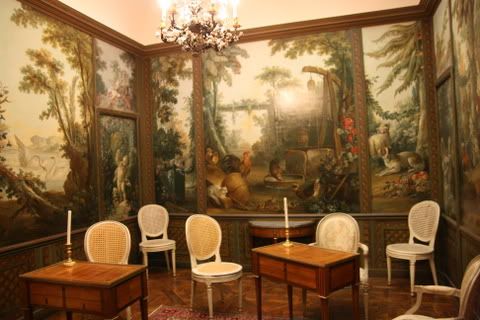
Ha! And they think our dogs are spoiled:
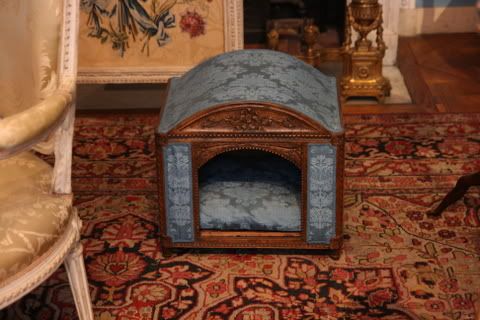
One of the original faces that adorn the Pont Neuf bridge


This room was just bizarre
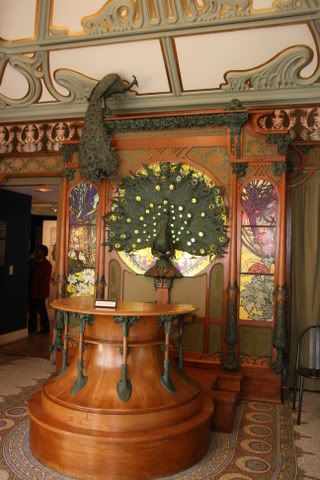
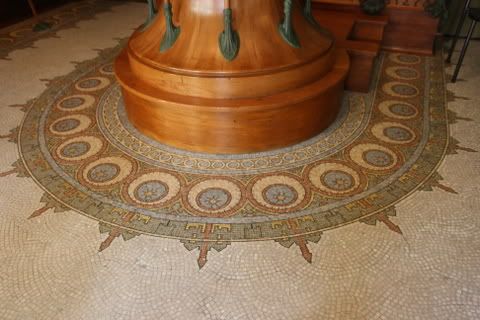
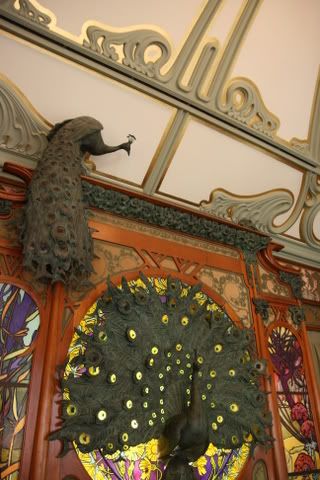
Beautiful table
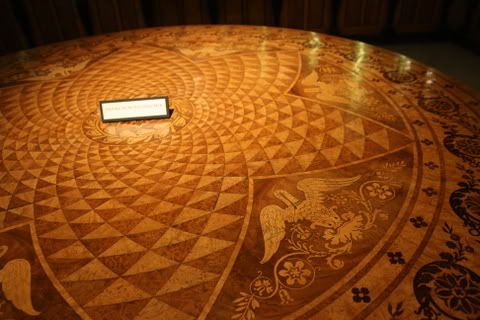
Painting of a monument being erected. I found the old construction techniques to be very interesting
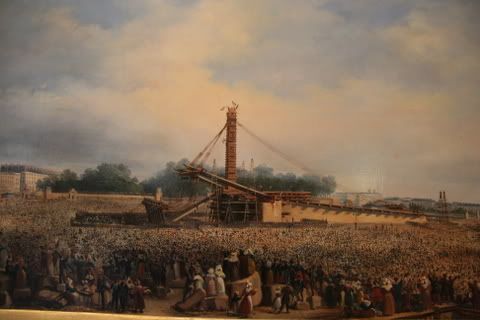
pieces of a statue that was destroyed
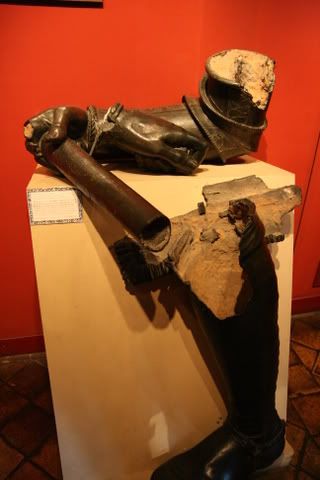
Some of Marie Antoinette’s hair
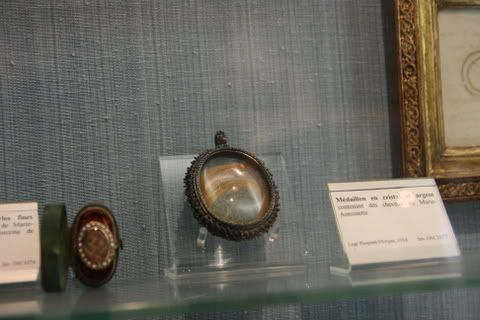
A little ivory guillotine toy

This was a revolution era clock. It tells the time, date and month. Notice how there are only 10 months in the revolutionary calendar
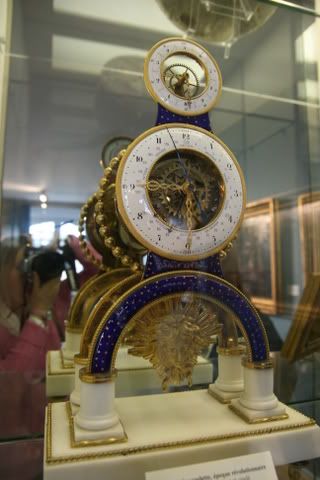
The remains of an infant in the Roman Gallo exhibit
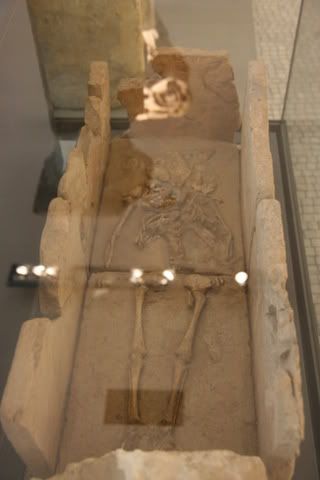
Roman glass, it is amazing that this has survived
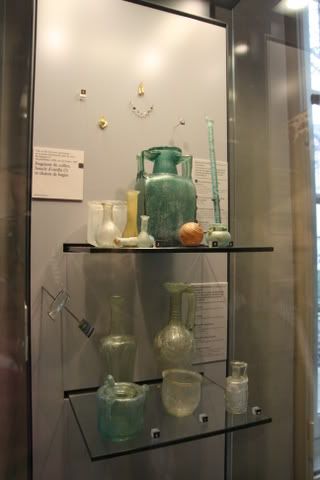
After the museum we were free to do what ever we wanted. The Carnavalet museum is very close to the Pompidou, so it would make sense to see both on the same day. Since we had already explored this area we got on the metro and headed to the other side of the city.
We saw this on the way to the metro. A brabus smart car

Erin still hadn't gotten Eiffel Tower pictures so we made a quick stop there.
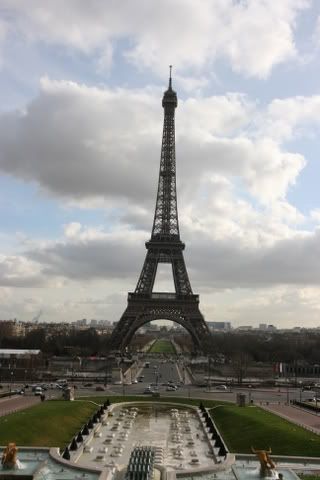
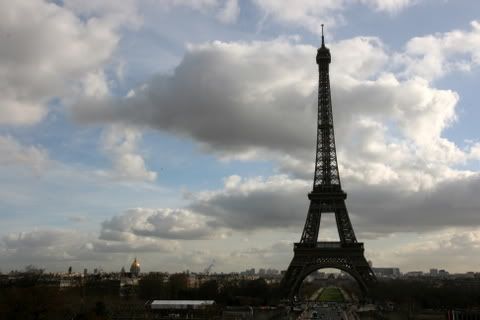
From there we headed to La Defance. This is where most of the modern buildings in Paris are houses. In the 1970s a very tall, ugly black rectangular building was erected in Paris. The outrage over this building was so much that it prevented any more from being built within old Paris. For the better anyways. Since the bedrock under the city is swiss cheese from quarrying, many areas can't support the structures anyways. The new construction moved out to La Defance, on the city's edge, where most of the new, high tech, offices now are. This is also where you can find the new arc, which is lined up perfectly with the Arc de Triomphe
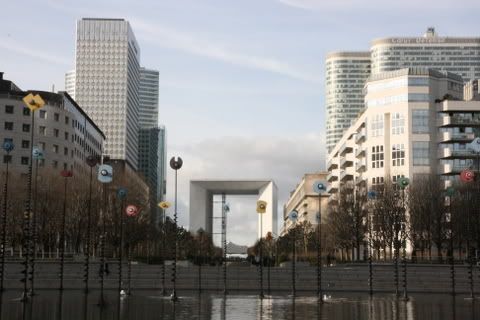
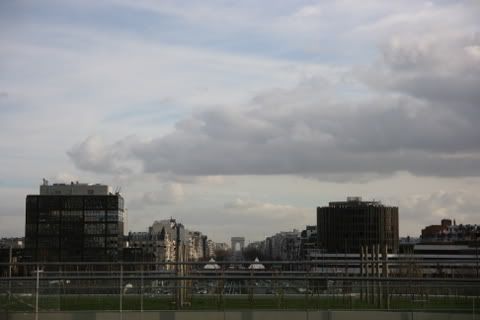
This is a bunch of pipes put together. There were a number of large, cylinder shaped pieces in this area
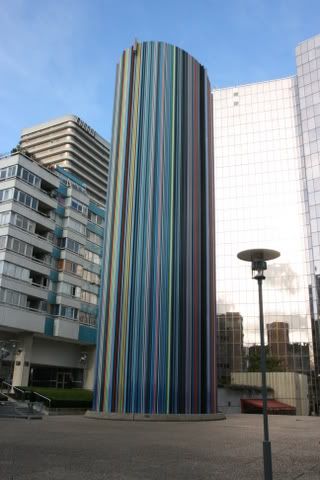
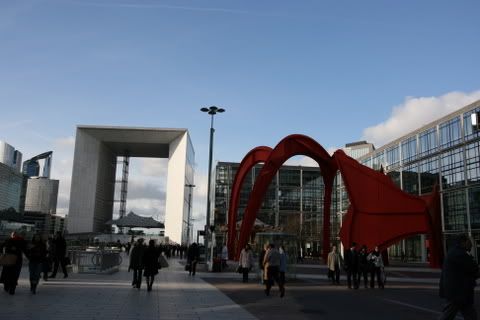
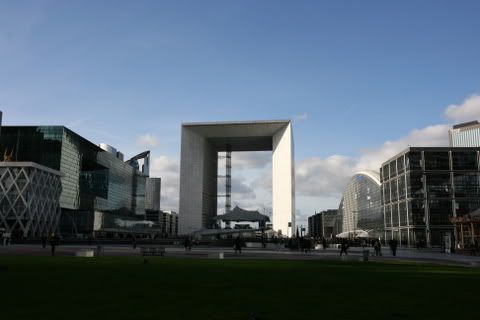
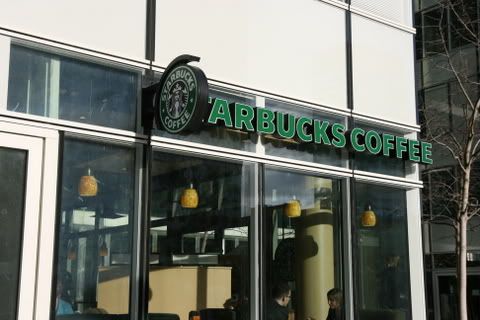
Men in trees

Before coming over here we were told by our Professor of the things not to speak to the French about. Politics was on his list. However, the French have taken quite the interest to our Presidential race because of Barack Obama. When we went to the Opera House, the men who checked our bags asked if we were American. We said yes and they said: "Obama! Obama! Obama!". When our Professor went out to dinner with some Parisian friends they kept asking him about him too. The French are so amazed that we are having a black run for president, and that he actually has a shot.

When we returned from La Defance both Erin and I were feeling sick to our stomachs. From 2pm on we slept and threw up. Today we are just staying inside. It’s okay, we saw everything we wanted to see anyways. We did want to leave the city to see the little town of Chartres which has one of the most beautiful cathedrals in France, but resting is better. It’s just a shame that the only station we have in English is CNN, we’ve seen the news play through so many times already.
We come back home tomorrow and even though we’ve had a ot of fun, I’m more than ready to leave.
This bronze statue of Louis the 14th was one of the few to survive the revolution

Painting of the Pont Neuf bridge

Erin shows off this beautiful and little bed

Painting of Les Invalaides before all of the development went up around it

Fire at a hotel. It made us laugh because the fire looks quite a bit like the fire symbol we saw on the exit signs


This painting is of the Champs Elysees, you can see it in the left hand side of the painting. It ends at the gardens of the Tuileries

Some of the walls within the museum:







Ha! And they think our dogs are spoiled:

One of the original faces that adorn the Pont Neuf bridge


This room was just bizarre



Beautiful table

Painting of a monument being erected. I found the old construction techniques to be very interesting

pieces of a statue that was destroyed

Some of Marie Antoinette’s hair

A little ivory guillotine toy

This was a revolution era clock. It tells the time, date and month. Notice how there are only 10 months in the revolutionary calendar

The remains of an infant in the Roman Gallo exhibit

Roman glass, it is amazing that this has survived

After the museum we were free to do what ever we wanted. The Carnavalet museum is very close to the Pompidou, so it would make sense to see both on the same day. Since we had already explored this area we got on the metro and headed to the other side of the city.
We saw this on the way to the metro. A brabus smart car

Erin still hadn't gotten Eiffel Tower pictures so we made a quick stop there.


From there we headed to La Defance. This is where most of the modern buildings in Paris are houses. In the 1970s a very tall, ugly black rectangular building was erected in Paris. The outrage over this building was so much that it prevented any more from being built within old Paris. For the better anyways. Since the bedrock under the city is swiss cheese from quarrying, many areas can't support the structures anyways. The new construction moved out to La Defance, on the city's edge, where most of the new, high tech, offices now are. This is also where you can find the new arc, which is lined up perfectly with the Arc de Triomphe


This is a bunch of pipes put together. There were a number of large, cylinder shaped pieces in this area




Men in trees

Before coming over here we were told by our Professor of the things not to speak to the French about. Politics was on his list. However, the French have taken quite the interest to our Presidential race because of Barack Obama. When we went to the Opera House, the men who checked our bags asked if we were American. We said yes and they said: "Obama! Obama! Obama!". When our Professor went out to dinner with some Parisian friends they kept asking him about him too. The French are so amazed that we are having a black run for president, and that he actually has a shot.

When we returned from La Defance both Erin and I were feeling sick to our stomachs. From 2pm on we slept and threw up. Today we are just staying inside. It’s okay, we saw everything we wanted to see anyways. We did want to leave the city to see the little town of Chartres which has one of the most beautiful cathedrals in France, but resting is better. It’s just a shame that the only station we have in English is CNN, we’ve seen the news play through so many times already.
We come back home tomorrow and even though we’ve had a ot of fun, I’m more than ready to leave.
Monday, January 21, 2008
Day 7: The Pompidou, The Pantheon, and walking about
On Mondays most museums are closed. The Pompidou is one of the few left open, and is a good call for spending a Monday afternoon. I won't lie, I wasn't excited about seeing this museum. I'm in one of the most beautiful historical cities in the world, surrounded by things built hundreds of years ago, things sculpted before Paris was a city, things painted before Columbus was born. And I'm going to spend a day seeing a canvas with a few strokes of paint on it called "art"? It just didn't seem like the best way to spend the day. But itineraries are itineraries, so we embarked.
The building of the Pompidou is well worth the visit. The Pompidou sits on top of one of the oldest parts of the city. Many of these buildings that were nearly a millennia old were demolished for the construction of the museum. The buildings around it are still very old, so you can get an idea of what used to be here. Sat down in the middle of these small cobblestone streets and the myriad of chimneys coming out of the tired shingled roofs of the compacted buildings is this:
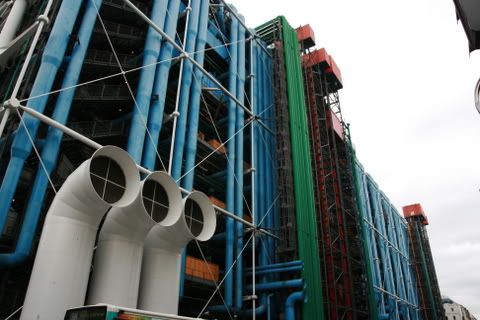


It is a very interesting and cool building that is for sure, and it 100% does not match any of what is around it. But, it adds to its appearance instead of diminishes it. If it were surrounded by other modern architecture you wouldn't notice it, but here it is as if it is one red elephant in a pack of grey ones, you can't help but notice it.
Juxtapositions:

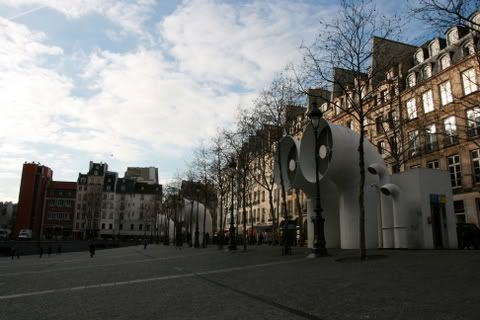
We went to the top of the exterior escalator and got a great view of the city:
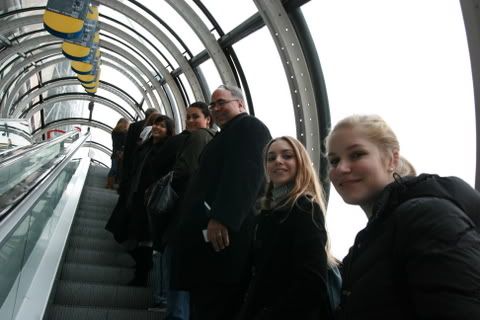
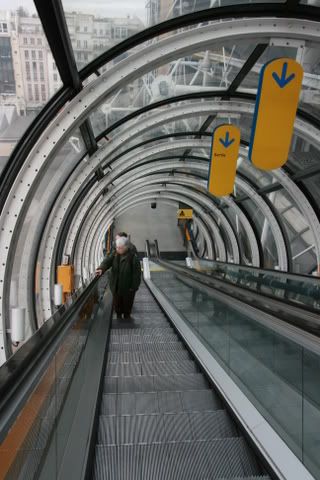
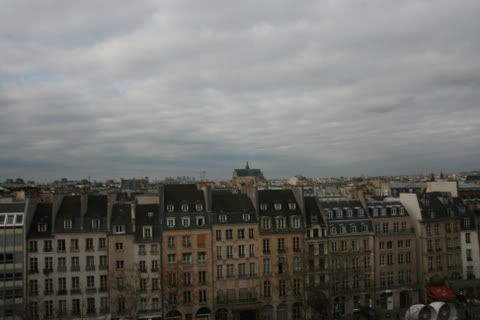
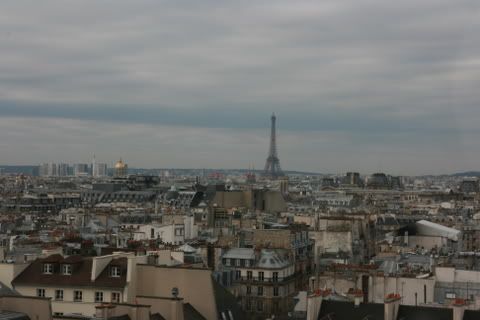


At this point I felt like I could just leave, I had no desire to see the art inside, but I'm really glad I did go inside. It really changed my perception on modern art, and I realized that a lot of it is very good. I had a lot of fun photographing people enjoying (sometimes not) the art as well.
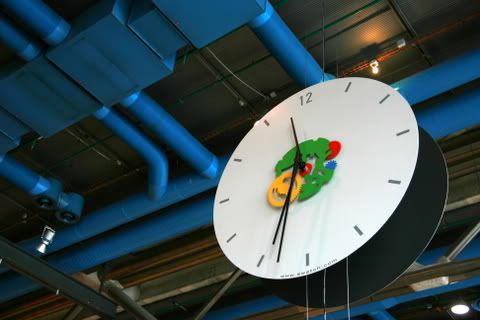
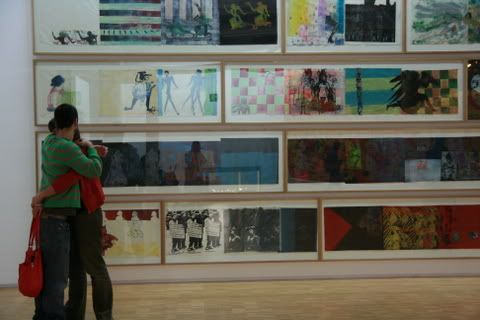

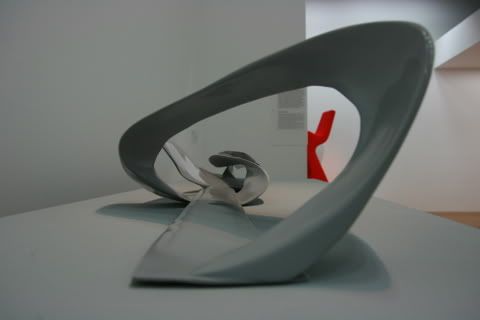
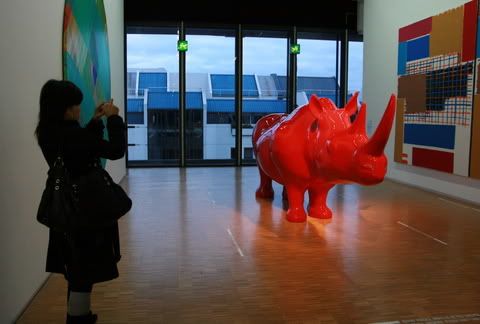
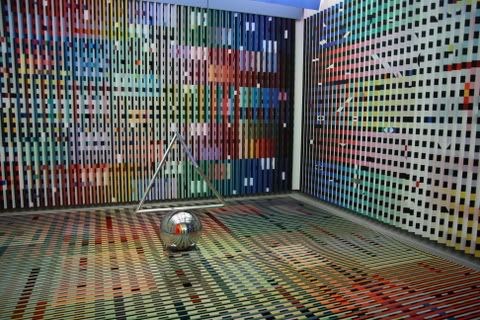
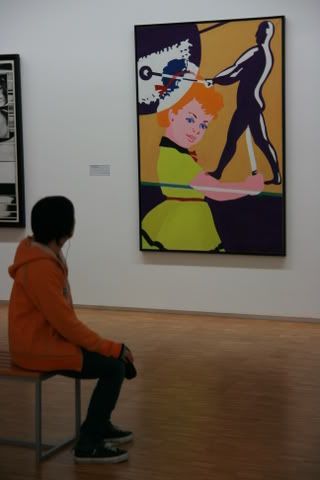
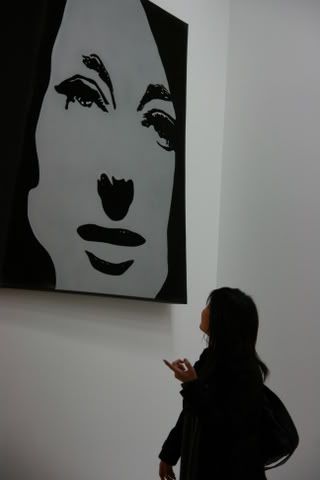

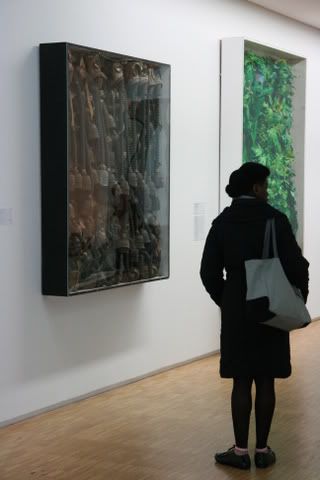
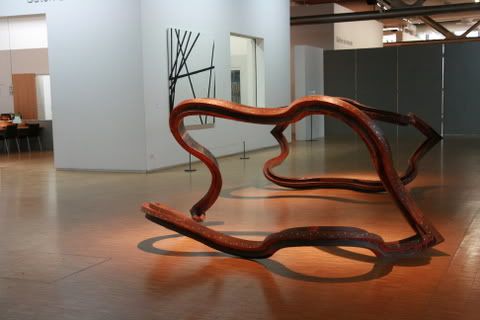
This is more of what I was expecting to see. Artist 1: "Look, at the art I have created. It makes a statement about how the monochromatic and conformist world crushes those with a view that differs from the mainstream." Artist 2: "Brilliant!"
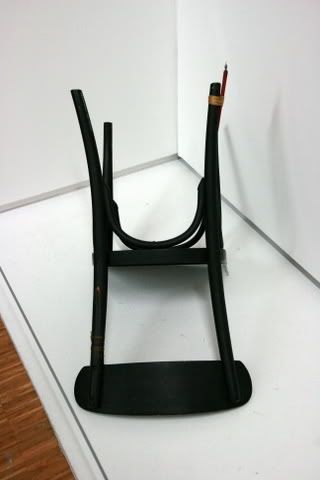
After the Pompidou Erin and I just wondered around a little. We worked our way to the Ise de la cite, then over onto the Ise de St. Louis. From there we went to the Latin Quarter. Here are just some of the photos I took along the way:

It was a windy day:
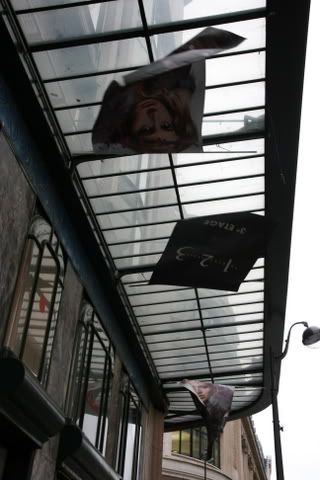
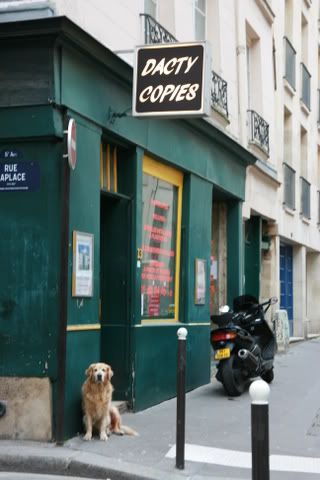
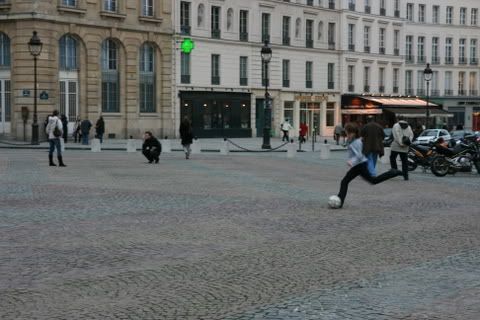
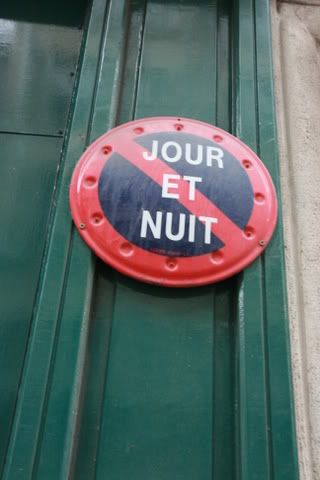
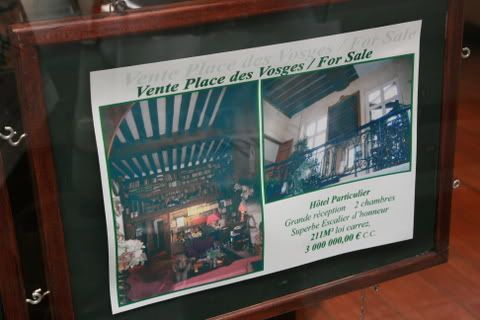
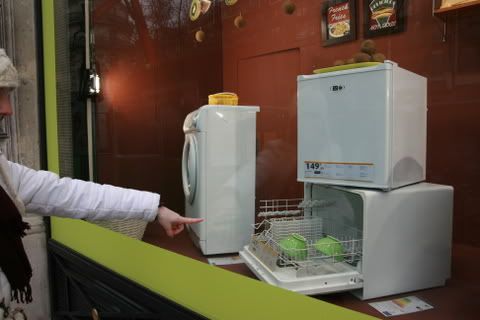
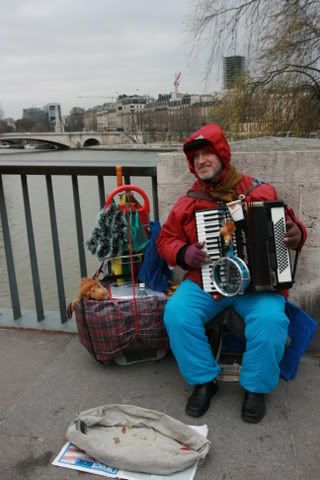
In the Latin Quarter we had some hot chocolate and then went to the Pantheon.
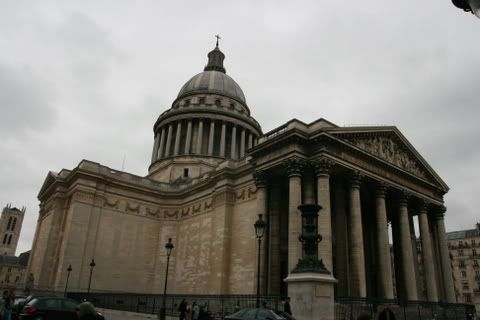

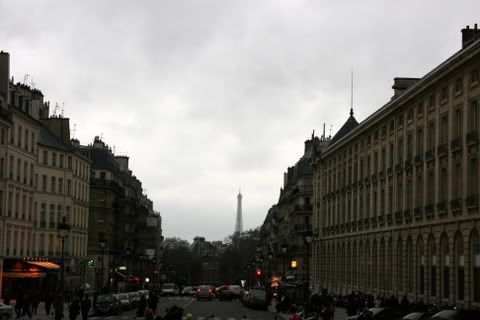
The Pantheon is one of the most schizophrenic buildings in all of Paris. It was originally a Church, but done in a very Roman theme. The Church itself broke a lot of boundaries: it was in the shape of a Greek cross instead of a Roman cross, it disguised the flying buttresses with outside walls, and was done in a much different style from the Gothic cathedrals seen around the city.
The church was to be dedicated to the patron saint of Paris St. Genevieve, who legend has kept off the invading Huns with her prayers. The church was finished right at the start of the French Revolution. The French Revolution went very anti-church. Notre Dame was even threatened to be destroyed in their quest to destroy the Catholic church. After that its role continued to transfer back and forth from a religious establishment to a secular one with each ruling party that followed after the Revolution. In the end, secularism won out, and currently the church is the final resting place to some of France's greatest thinkers.
The inside was painted under Napoleon(?) to show scenes of great French catholic tradition; such as the life and death of Joan of Arc, the story of St. Genevieve, etc.

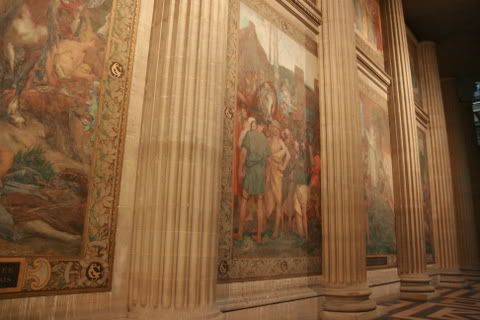
A statue of the Republic:
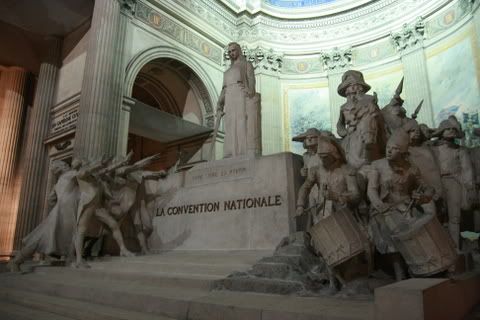
After exploring the main floor we went downstairs to the Crypt
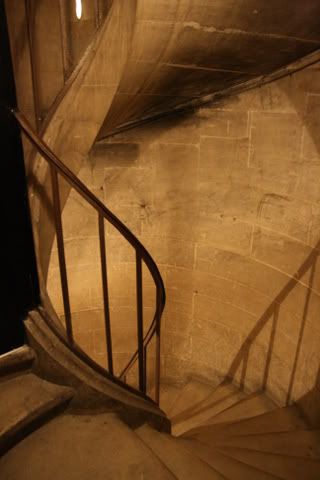

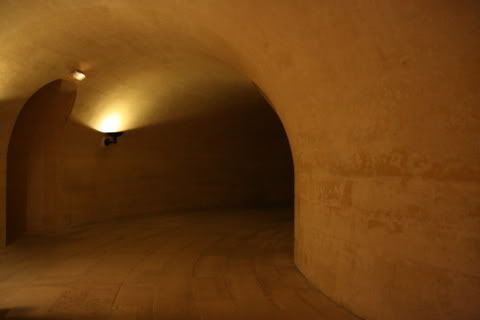

I won't lie, I tried to touch it, but I couldn't reach :(
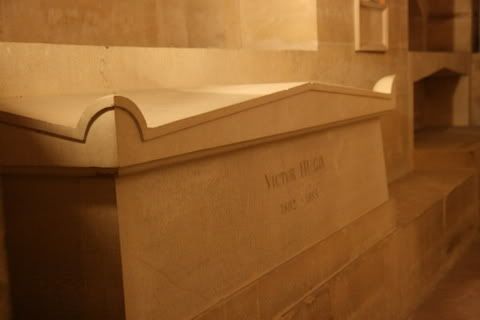
Voltaire and Rousseau are also buried here.
Erin shows how different the French restrooms are from ours. The separation from men to women is so much less:
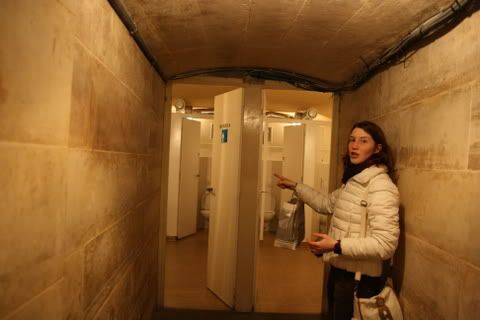
After this we got back on the subway and went back to Fauchon so Erin could get some chocolate:
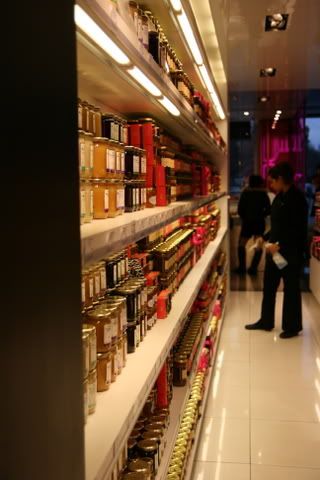

Not everything delicious at Fauchon is edible

this was found in the subway on the way back to the hotel
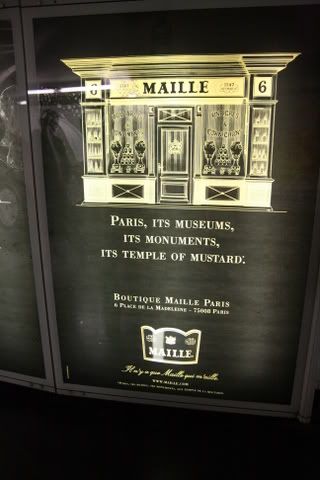
I had Indian food for dinner for the first time tonight. Again, much better than French food. I loved it.
The building of the Pompidou is well worth the visit. The Pompidou sits on top of one of the oldest parts of the city. Many of these buildings that were nearly a millennia old were demolished for the construction of the museum. The buildings around it are still very old, so you can get an idea of what used to be here. Sat down in the middle of these small cobblestone streets and the myriad of chimneys coming out of the tired shingled roofs of the compacted buildings is this:



It is a very interesting and cool building that is for sure, and it 100% does not match any of what is around it. But, it adds to its appearance instead of diminishes it. If it were surrounded by other modern architecture you wouldn't notice it, but here it is as if it is one red elephant in a pack of grey ones, you can't help but notice it.
Juxtapositions:


We went to the top of the exterior escalator and got a great view of the city:






At this point I felt like I could just leave, I had no desire to see the art inside, but I'm really glad I did go inside. It really changed my perception on modern art, and I realized that a lot of it is very good. I had a lot of fun photographing people enjoying (sometimes not) the art as well.











This is more of what I was expecting to see. Artist 1: "Look, at the art I have created. It makes a statement about how the monochromatic and conformist world crushes those with a view that differs from the mainstream." Artist 2: "Brilliant!"

After the Pompidou Erin and I just wondered around a little. We worked our way to the Ise de la cite, then over onto the Ise de St. Louis. From there we went to the Latin Quarter. Here are just some of the photos I took along the way:

It was a windy day:







In the Latin Quarter we had some hot chocolate and then went to the Pantheon.



The Pantheon is one of the most schizophrenic buildings in all of Paris. It was originally a Church, but done in a very Roman theme. The Church itself broke a lot of boundaries: it was in the shape of a Greek cross instead of a Roman cross, it disguised the flying buttresses with outside walls, and was done in a much different style from the Gothic cathedrals seen around the city.
The church was to be dedicated to the patron saint of Paris St. Genevieve, who legend has kept off the invading Huns with her prayers. The church was finished right at the start of the French Revolution. The French Revolution went very anti-church. Notre Dame was even threatened to be destroyed in their quest to destroy the Catholic church. After that its role continued to transfer back and forth from a religious establishment to a secular one with each ruling party that followed after the Revolution. In the end, secularism won out, and currently the church is the final resting place to some of France's greatest thinkers.
The inside was painted under Napoleon(?) to show scenes of great French catholic tradition; such as the life and death of Joan of Arc, the story of St. Genevieve, etc.


A statue of the Republic:

After exploring the main floor we went downstairs to the Crypt




I won't lie, I tried to touch it, but I couldn't reach :(

Voltaire and Rousseau are also buried here.
Erin shows how different the French restrooms are from ours. The separation from men to women is so much less:

After this we got back on the subway and went back to Fauchon so Erin could get some chocolate:


Not everything delicious at Fauchon is edible

this was found in the subway on the way back to the hotel

I had Indian food for dinner for the first time tonight. Again, much better than French food. I loved it.
Subscribe to:
Posts (Atom)